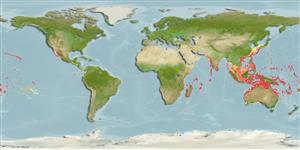>
Acanthuriformes (Surgeonfishes) >
Pomacanthidae (Angelfishes)
Etymology: Centropyge: Greek, kentron = sting + Greek, pyge = tail (Ref. 45335).
Eponymy: Dr Walter Kenrick Fisher (1878–1953) was a botanist and zoologist. [...] (Ref. 128868), visit book page.
More on author: Snyder.
Environment: milieu / climate zone / depth range / distribution range
экология
морской ассоциированный с рифами; немигрирующий; пределы глубины 10 - 95 m (Ref. 58302), usually 24 - ? m. Tropical
Indo-West Pacific: widespread, from the Gulf of Aden and Oman along the East African
coast to South Africa to the Tuamotu archipelago, north-eastward to the Johnston Atoll and Hawaii, northward up to Ogasawara Island, southward through the Coral Sea down to New South Wales, Australia.
Size / Вес / Возраст
Maturity: Lm ? range ? - ? cm
Max length : 8.4 cm TL самец/пол неопределен; (Ref. 30840)
This species differs from its congeners in having an almost transparent (except for
a dark anterior part of the dorsal- and ventral margin), slightly whitish to yellowish caudal fin
versus the dark blue caudal fin in C. argi and C. aurantonotus or a bright yellow to orange caudal fin with a dark blue distal margin in C. resplendens Ref. 53274).
Benthopelagic species found in reefs (Ref. 58302); in coral bottoms of channels and over reef slopes (Ref. 9710); also in areas with rubble bottom (Ref. 4858). Often in small loose groups on inner reefs in low patches of brittle corals and coralline algae mix that is shared by damselfishes and small wrasses (Ref. 48636). Herbivorous (Ref. 33482). Occasionally exported through the aquarium trade (Ref. 48391).
Life cycle and mating behavior
половая зрелость | размножение | нерест | икра | Fecundity | личинки
Bi-directional sex change has been confirmed for this species (Ref. 103751).
Allen, G.R., 1985. Butterfly and angelfishes of the world. Vol. 2. 3rd edit. in English. Mergus Publishers, Melle, Germany. (Ref. 4858)
Статус Красного Списка МСОП (Ref. 130435: Version 2024-2)
Угроза для людей
Harmless
Использование человеком
рыболовство: коммерческий; аквариум: коммерческий
дополнительная информация
инструменты
Специальные отчеты
Скачать в формате XML
ресурсы в Интернет
Estimates based on models
Preferred temperature (Ref.
123201): 23.6 - 28.4, mean 27.1 °C (based on 258 cells).
Phylogenetic diversity index (Ref.
82804): PD
50 = 0.5000 [Uniqueness, from 0.5 = low to 2.0 = high].
Bayesian length-weight: a=0.03311 (0.01668 - 0.06575), b=2.83 (2.66 - 3.00), in cm total length, based on LWR estimates for this species & (Sub)family-body (Ref.
93245).
Trophic level (Ref.
69278): 2.8 ±0.33 se; based on food items.
устойчивость к внешним воздействиям (Ref.
120179): высокий, минимальное время удвоения популяции до 15 месяцев (Preliminary K or Fecundity.).
Fishing Vulnerability (Ref.
59153): Low vulnerability (10 of 100).
Nutrients (Ref.
124155): Calcium = 117 [56, 178] mg/100g; Iron = 0.757 [0.460, 1.275] mg/100g; Protein = 18 [17, 19] %; Omega3 = 0.136 [0.078, 0.226] g/100g; Selenium = 28.3 [15.0, 53.6] μg/100g; VitaminA = 108 [29, 388] μg/100g; Zinc = 1.81 [1.22, 2.61] mg/100g (wet weight);
